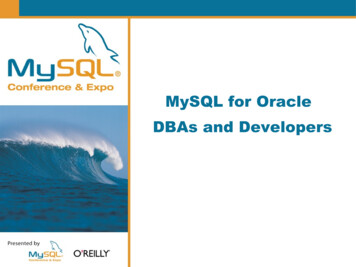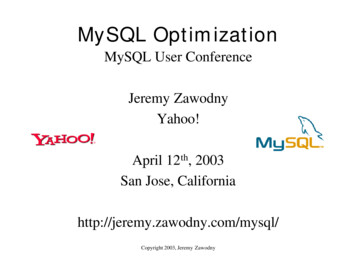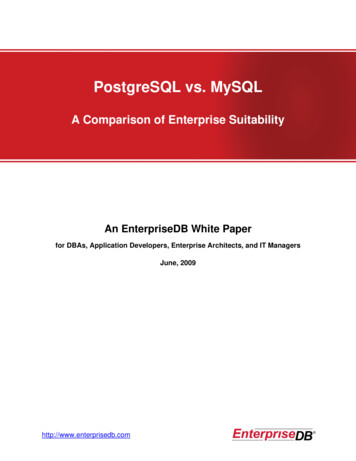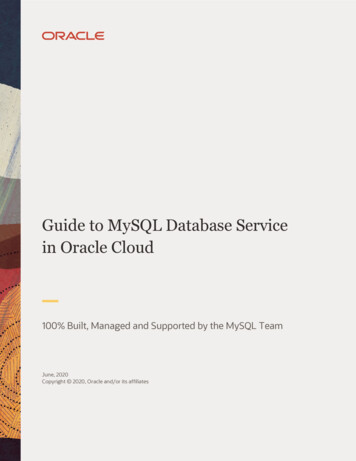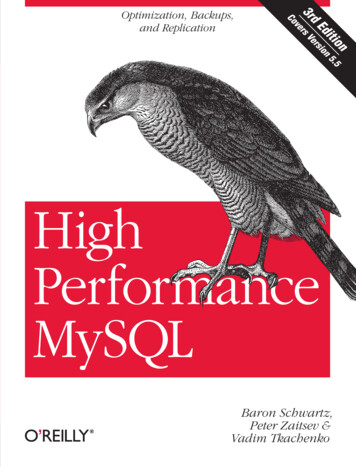
Transcription
MySQL 8.0 Performance:Tuning for High LoadDimitri KRAVTCHUKMySQL Performance Architect @OracleCopyright 2012, Oracle and/or its affiliates. All rights reserved.Insert Information Protection Policy Classification from Slide 12Insert Picture Here
The following is intended to outline our general productdirection. It is intended for information purposes only, and maynot be incorporated into any contract. It is not a commitment todeliver any material, code, or functionality, and should not berelied upon in making purchasing decisions. The development,release, and timing of any features or functionality describedfor Oracle’s products remains at the sole discretion of Oracle.
Are you Dimitri?. ;-) Yes, it's me :-) Hello from Paris! ;-) Passionated by Systems and Databases Performance Previous 15 years @Sun Benchmark Center Started working on MySQL Performance since v3.23 But during all that time just for “fun” only ;-) Since 2011 “officially” @MySQL Performance full time now http://dimitrik.free.fr/blog / @dimitrik fr
Agenda Overview of MySQL PerformanceTuning & WorkaroundsQ&A
Why MySQL Performance ?.
Why MySQL Performance ?. Any solution may look “good enough”.
Why MySQL Performance ?. Until it did not reach its limit.
Why MySQL Performance ?. And even improved solution may not resist to increasing load.
Why MySQL Performance ?. And reach a similar limit.
Why MySQL Performance ?. Analyzing your workload performance and testing your limits may help youto understand ahead the resistance of your solution to incoming potentialproblems ;-)
Why MySQL Performance ?. However : Even a very powerful solution butleaved in wrong hands may still beeasily broken!. :-)
The MySQL Performance Best Practice #1is. ?.
The MySQL Performance Best Practice #1is. ?.USE YOUR BRAIN !!! ;-)
The MySQL Performance Best Practice #1is. ?.USE YOUR BRAIN !!! ;-)THE MAINSLIDE! ;-))
#2 - Monitoring is THE MUST !even don’t start to touch anythingwithout monitoring. ;-)
You can be surprised but what you may discover. MySQL Activity :
The Infinitive Loop of Database Tuning.ApplicationDB Engine#1 Monitoring #2 Tuning #3 Optimization #4 Improvement(s) #5 . goto #1 OSHW HostStorage
The Infinitive Loop of Database Tuning.Even if in95% casesthe problemis here!!! :-)ApplicationDB Engine#1 Monitoring #2 Tuning #3 Optimization #4 Improvement(s) #5 . goto #1 OSHW HostStorage
Sources of information MySQL / InnoDB : show engine innodb status show engine innodb mutex INNODB METRICS show global status Performance Schema (PFS) / SYS Schema System (linux) perf top -z quick overview of what is hot vmstat / mpstat / iostat / etc. pstack / quickstack for debugging only
Hosting System CPU latest / fastest Network connect rate / SSL connection multiplexing (via proxy ?) VM ? check driver scalability / limits Storage flash ! (please, love your data !) OS jemalloc !!!
RO Point-Selects @MySQL 8.0 (Dec.2017) Sysbench Point-Selects 10Mx8tab @2CPU Sockets 2CPU Sockets Broadwell v4 : 44cores-HT 2CPU Sockets Skylake Platinum : 48cores-HT near 80% gain in peak QPS !! already 50% on 32usr load !!
A B-shit Slide Odd interpretation of Scalability
A B-shit Slide (2) Odd interpretation of Scalability Then, keep the load Scale up to N connectionsBoth are scaling up to 64 connections,but only one is able to keep a higher load.
MySQL on High Load Once you’ve reached your Max TPS on your system : try to understand first what is limiting you? (I/O, CPU, Network, MySQL internals?) the next goal then: to avoid a TPS “regression” on a higher load How to keep your Max TPS on a higher load too? the dumb rule : avoid to have a load higher than you’re able to keep ! ;-) seriously : if you hit internal contention (MySQL code) limiting InnoDB thread concurrency may helpif you hit data contention (your app code) limiting transaction concurrency may help as wellyour best friends : ThreadPool / ProxySQL / etc. NOTE : there is no “magic” for response time : if your Max TPS you’re reaching on N usersand able to keep the same Max TPS on N x2 users (or x3, x4, etc.)your response time may only grow! (and be x2 times bigger (or x3, or x4, etc.))
Recognize your Workload by “pattern” ;-) In-Memory Workload : you don’t have IO reads IO-bound Workload : you have IO reads ;-)) Read-Only (RO) : you don’t have any data writes Read Write (RW) : you have data writes ;-))
In-Memory Read-Only Scalability RO : since MySQL 5.7 is “generally” OK, but workaround : ProxySQL Query Cache Block Locks possible workaround : use PK, AHI Lookups via Sec.IDX use 8.0 ;-) UTF8
IO-bound Read-Only Scalability RO : since MySQL 5.7 is “generally” OK, but workaround : ProxySQL Query Cache Block Locks possible workaround : use PK, AHI Lookups via Sec.IDX use 8.0 ;-) UTF8 Global lock on every IO read use 8.0 ;-)
IO-bound Point-Selects @MySQL 8.0 (Apr.2018) IO-bound Sysbench OLTP RO Point-Selects 50M x 8-tables, 48cores-HT, x2 Optane drives NOTE : storage saturated & 100% CPU (new face of IO-bound ? ;-)) over 1M IO-bound QPS with MySQL 8.0 !!!
Read Write Scalability RW : always has IO writes ! storage is very important ! max REDO write rate your max TRX rate (TPS) REDO write fsync latency your TRX response time In-Memory : REDO writes background(!) DATA writes (dirty pages flushing) as long as DATA flushing follows your REDO writes all OK big enough REDO size can lower requirement for storage performance IO-bound : REDO writes awaited(!) DATA writes DATA reads ! you can read DATA only into Free page if no more Free pages TRX stall. storage capacity becomes extremely important !
In-Memory RW Tuning REDO size go with 8GB - 32GB (N files x 1GB) IO capacity innodb io capacity : value used for all kind of background flushing innodb io capacity max : value used only for adaptive flushingdefault : innodb io capacity x 2 (min: 2000) Dirty Pages % innodb max dirty pages pct & innodb max dirty pages pct lwm BP instances on high load you’ll need to flush more data in parallel using many BP instances is the way to achieve it N page cleaners Flush Method AIO on & innodb flush method O DIRECT or O DIRECT NO FSYNC
Example : OLTP RW 10Mx8tab / 50Mx8tab my.conf : innodb adaptive hash index 0 ## (!!!) innodb log file size 1024M innodb log files in group 32 innodb io capacity 10000 innodb io capacity max 40000 innodb buffer pool size 128000M innodb buffer pool instances 16 innodb page cleaners 16 innodb max dirty pages pct 90 innodb max dirty pages pct lwm 10 innodb adaptive flushing 1 innodb flush method O DIRECT NO FSYNC innodb use native aio 1
Example : OLTP RW 10Mx8tab / 50Mx8tab Workload Scenario : 10Mx8tab on left & 50Mx8tab on right progressing step-by-step load from 1, 2, 4 . till 1024 concurrent user sessions
Monitoring : Checkpoint Age & Flushing Target : Checkpoint Age must remain under max REDO limit have marge Adaptive Flushing must follow required Flush Rate remain under 1sec
Monitoring : Checkpoint Age & Flushing (2) Target : Checkpoint Age must remain under max REDO limit have marge Adaptive Flushing must follow required Flush Rate remain under 1sec
Monitoring : Who Requests Flushing ? Target : Flushing requested due reached Dirty Pages % level or REDO % level in current case the main request is coming from Dirty Pages %
Monitoring : What about Buffer Pool ? Target : Workload is “in-memory”, so 100% BP hit is as expected but why amount of Free Pages is going down with higher load ?(yellow)
Monitoring : What is the Free Page Demand ? Target : Free Page requests/sec any waits / loops ? no.
Monitoring : What about Purge Activity ? Target : History Length (should not grow constantly) Purge Activity (should always progress)
Workaround : Involve Write Throttling on Purge Lag Tuning : innodb max purge lag delay 300000 innodb max purge lag 10M
Workaround : Involve Write Throttling on Purge Lag (2) Tuning : innodb max purge lag delay 300000 innodb max purge lag 10M
UNDO Auto-Truncate Impact Update NoKEY 50Mx8tab, BP 256G mostly fixed, but workaround : innodb undo log truncate offand truncate manually when no user activity
MySQL 8.0 : Re-Designed REDO Old design -vs- New design (simplified) :FS cacheLog BufferLog WriterLog FlusherFS cacheLog BufferREDOREDO
MySQL 8.0 : Re-Designed REDO New design tradeoffs FS cache 1 user / low load event-driven is slower option : spinning on wait option : low/ high/ mixed orientedLog BufferLog WriterLog FlusherFS cacheLog BufferREDOREDO
MySQL 8.0 : Re-Designed REDO New design tradeoffs innodb log wait for flush spin hwm : fsync max usec time (def: 400) innodb log spin cpu pct hwm : max CPU% usage (def: 50)MySQL 8.0 : adaptive spinning- CPU usage hwm- flush time hwm
Monitoring : REDO stats Target : CPU% REDO flush time Avg / Max
Monitoring : REDO stats Target : REDO flush time Avg REDO writes MB/sec
Monitoring : REDO stats Target : REDO writes/sec REDO fsync/sec
IO-bound RW Tuning All previous for In-Memory is still valid ;-)) LRU Depth check the Free Page request rate tune LRU Depth accordingly. LRU Depth Free Pages requests/sec / BP instances Example : innodb buffer pool instances 24innodb page cleaners 24innodb lru scan depth 10K Check if IO reads are not blocking your IO writes ;-)) limiting thread concurrency to lower IO reads ex. innodb thread concurrency 64 using 4K page size can help to lower IO activity if data access is mostly random NOTE : right now there is NO limits for IO reads / writes for such kind of workloads !
Example : OLTP RW 50Mx8tab with 64G / 32G BP Workload Scenario : BP 64G on left & BP 32G on right progressing step-by-step load from 1, 2, 4 . till 1024 concurrent user sessions
Monitoring : Free Pages Request Rate Target : get free search/sec Free Pages Request Rate loops : “loops in wait” (not good) waits : real stalls on free page waits. (very bad)
Monitoring : LRU Flushing Target : does flushing following the Free Pages demand ? is there Single Page Flush ? (page flush by user thread)
Monitoring : Flushing Times Target : do we finish flushing within 1sec ? no. — and the fix here is to go with 32 or 48 BP instances ! ;-))
Once again about File System : EXT4 or XFS ? same OLTP RW, BP 64G, double write 0 same OLTP RW, BP 64G, double write 1
Double-Write Impact same OLTP RW, double write 0 / 1
Overall Scalability Issues RO : workaround : ProxySQL Query Cache Block Locks possible workaround : use PK, AHI Lookups via Sec.IDX use 8.0 ;-) UTF8 Global lock on every IO read use 8.0 ;-)RW : REDO log related bottlenecks. new REDO since 8.0 !! coming soon with 8.0 update (!!) Double Write. TRX management contentions. work-in-progress, prototyped. work-in-progress, prototyped. LOCK management. work-in-progress, prototyped. RR / RC isolation. use 8.0, and stay tuned ;-) UPDATE Performance. possible workaround : use partitions INSERT Performance. not yet solved, but you can truncate UNDO Purge lagging.
OLTP RW latin1 @MySQL 8.0 (Apr.2018) 45K (!!) TPS Sysbench OLTP RW 10Mx8tab, trx commit 1, 2S 30% gain vs MySQL 5.7 50% gain vs MySQL 5.6
Updates-NoKEY latin1 @MySQL 8.0 (Apr.2018) 250K (!!) QPS Sysbench Updates-nokey 10Mx8tab, trx commit 1, 2S 100% gain vs MySQL 5.7 50% gain vs MySQL 5.6 (and yes, 5.7 is bad here. fixed !! ;-)) and clearly seen MariaDB’s adoption of InnoDB 5.7.
Binlog Impact OLTP RW / Update NoKEY 10Mx8tab, BP 32G yes it sucks, yes we MUST do something. workaround :
Hope you’re seeing much more clear now ;-) And there is less mystery for you around MySQL Performance Tuning Most of stuff is available since MySQL 8.0 only. So, DON’T wait to try & upgrade !!! :-)
One more thing ;-) All graphs are built with dim STAT (http://dimitrik.free.fr) All System load stats (CPU, I/O, Network, RAM, Processes,.) Mainly for Linux, Solaris, OSX (and any other UNIX too :-)Add-Ons for MySQL, Oracle RDBMS, PostgreSQL, Java, etc.Linux : PerfSTAT (“perf” based), mysqlSTACK (quickstack based) mysqlSTAT : all available data from “show status”mysqlLOAD : compact data, multi-host monitoring orientedmysqlWAITS : top wait events from Performance SCHEMAInnodbSTAT : most important data from “show innodb status”innodbMUTEX : monitoring InnoDB mutex waitsinnodbMETRICS : all counters from the METRICS tableAnd any other you want to add! :-) MySQL Add-Ons: Links http://dimitrik.free.fr - dim STAT, dbSTRESS, Benchmark Reports, etc. http://dimitrik.free.fr/blog - Articles about MySQL Performance, etc.
Read Write Scalability RW : always has IO writes ! storage is very important ! max REDO write rate your max TRX rate (TPS) REDO write fsync latency your TRX response time In-Memory : REDO writes background(!) DATA writes (dirty pages flushing) as long as DATA flushing follows your REDO writes all OK big enough REDO size can lower requirement for .


